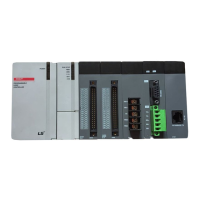Chapter 10 CPU Function
10.6.2 Time to Process the Forced I/O On/Off and Processing Method
(1) Forced input
When the forced input is set, among the data read from the input model at the time of Refresh, the data of the contact
set as the forced On/Off is replaced by the forced set data to update the input image area. Accordingly, during program
operation, among the actual input data, the forced set area is operated with the results replaced by the forced set data.
(2) Forced output
After completing the operation of user programs, at the time of output Refresh, among the data of the output
image areas including the operation results, the data of the contact set as the forced On/Off is replaced by the
forced set data, and then, they are output. Accordingly, in contrast with the forced input, in the case of the
forced output, the data of the output image area shows the same data with the program operation results but
the actual output changes by the forced output On/Off settings.
(3) Instructions to use the Forced I/O functions
• It work from the time of setting each I/O‘Enable’ after setting the forced data.
• Although the actual I/O modules are not equipped, the forced input can be set.
• In spite of Off On of the power, change of operation modes and operation by the reset key.
The previously set On/Off data is stored in the motion controller.
• Even in STOP mode, the forced input and output data is not eliminated.
• When you try to set the new data from the beginning, cancel all settings of I/O by using ‘Delete All’ before
use.
(4) Operations in case of errors
• When errors occur after setting the forced output, it works based on「Output Hold when errors occur」 of
output control settings in the basic parameters and 「Emergency Output」 of the I/O parameters. In case of
error occurrence, if you select the emergency output as 「Clear」 after setting Output Hold when errors
occur」, the output is off when errors occur; if you choose 「Hold」, the output status will be maintained.

